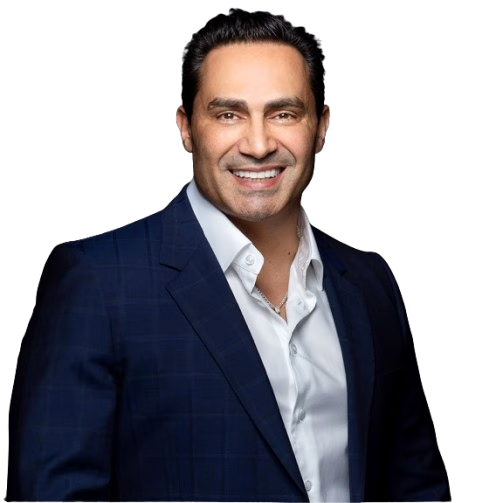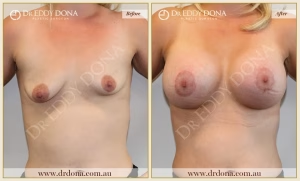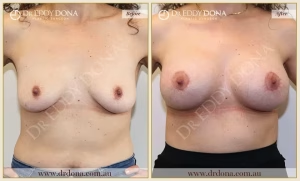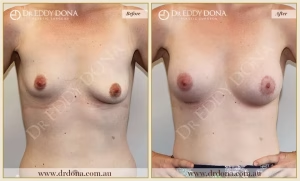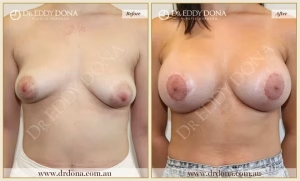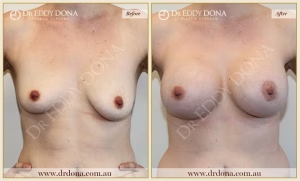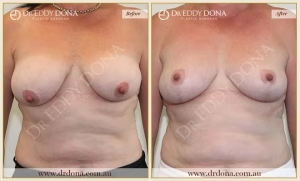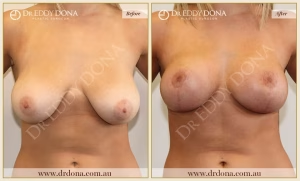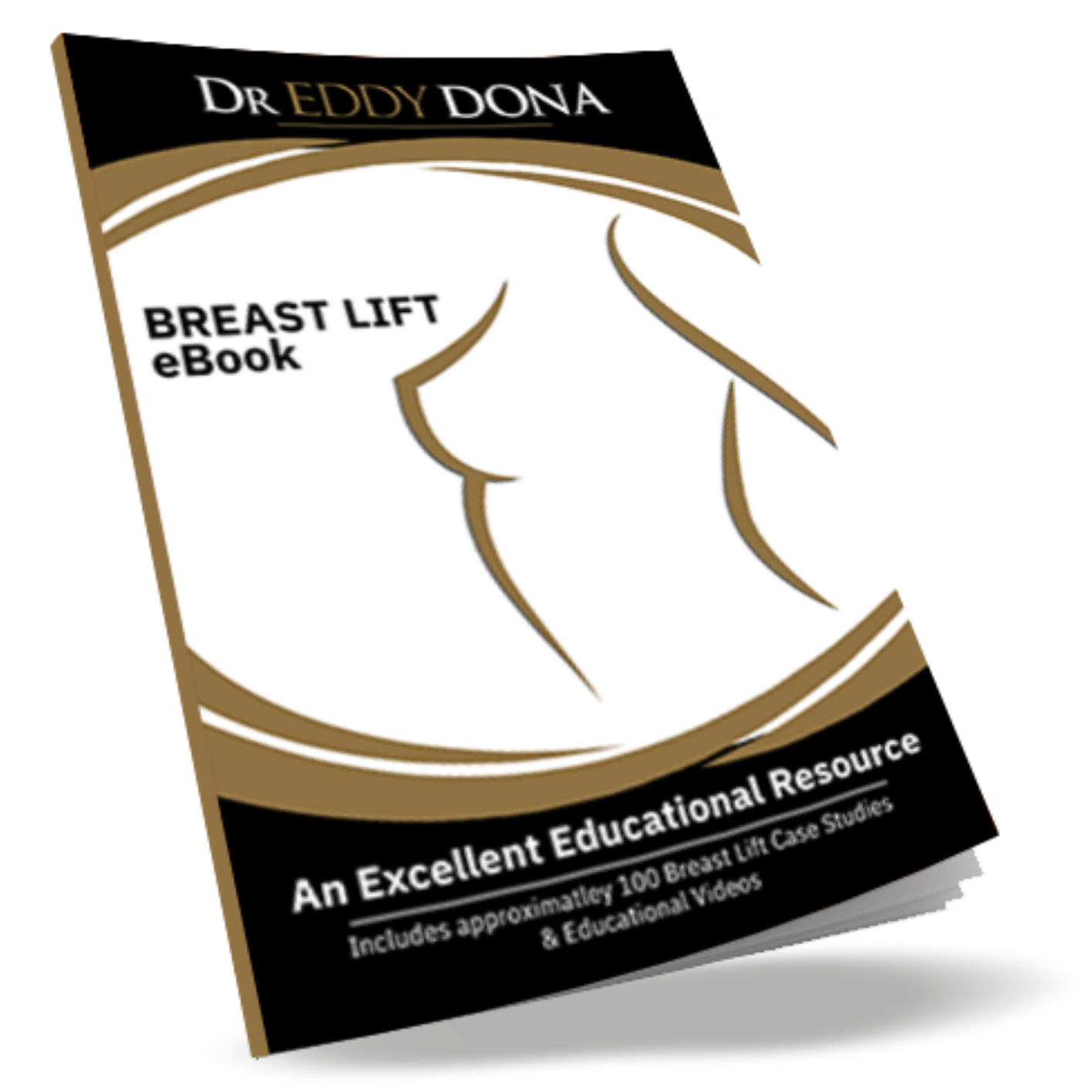Single or two stage Breast Lift (Mastopexy) Augmentation Surgery
A combined Breast Lift and Breast Augmentation Surgery is the most difficult of all cosmetic breast surgery procedures performed and because of this many plastic surgeons choose not to do them. Whilst some are much easier than others, in general they are extremely challenging.
So, prior to undergoing surgery patients need to be made aware of the complexity of this combination procedure, have realistic expectations, and understand that additional surgery (along with the additional recovery time, time off work, stress, expenses etc) may be necessary in the short or long-term.
A concept that one needs to understand is that a Breast Lift and Breast Augmentation Surgery requires the surgeon to increase the breast size with breast implants, whilst at the same time reducing the breast envelope (that is, removing skin and breast tissue in order to achieve the breast lift). These two potentially counterproductive actions must be balanced as perfectly as possible in order to achieve the desired results.
Ultimately, the surgeon needs to lift the nipple and breast tissue to ensure a uniform and “tight” distribution of the natural breast tissue over the chosen implant to create a uniform appearing and feeling breast mound.
During Breast Lift procedures the nipples remain attached to their blood and nerve supply while they are repositioned. Some of the technical difficulties and limitations of a Breast Lift Surgery is related to ensuring that you surgically don’t completely cut off all the blood supply to the nipple, which would basically mean the nipple would literally die and fall off!
Performing a Breast Lift without an implant allows Dr Dona to apply more surgical ‘manoeuvres’ designed to lift up the breast tissue to maximise the chance of the breast tissue remaining high. Every surgical step involved in a Breast Lift does to some degree cut off part of the blood supply to the nipple. When an implant is added to the equation, many of the steps involved in creating a pocket for the implant, and the pressure effect from the implant, further compromises the blood supply to the nipple. Therefore, Dr Dona often needs to limit the ‘manoeuvres’ required to maximally lift the breast tissue. Dr Dona also needs to reduce the maximal size of the implant that could otherwise be used for a simple Breast Augmentation. These limitations can add to the potential issue of the breast tissue re-sagging early after surgery.
The potential for re-sagging is even greater with breast tissue problems such as:
– Large breast tissue volumes
– Breast tissue that is very soft and lost its elasticity
– Breast tissue that is ‘detached’ from the underlying muscle and slides around
– Skin that is thin and has lost its elasticity
Given that women wanting a Breast Lift typically have one or more of these problems, then you can appreciate that one of the main issues with a Breast Lift with a combined Breast Augmentation is that the breast tissue doesn’t stay where we want it to stay.
Essentially the patient is needing a Breast Lift because they have weak and soft breast tissue quality which has dropped – yet that same breast tissue and skin still exists after surgery, and it’s therefore still wanting to drop. No surgery and no surgeon can change the quality or consistency of the breast tissue and skin – the objective will be to try and reposition and shape the breast tissue.
In addition to breast tissue that doesn’t necessarily stay where it’s meant too, breast implants don’t necessarily stay where we wish they would. Therefore, breast implant related problems such as positioning (too low, lateral slide etc.) can occur and may be a reason for returning to the operating room for further surgery. This is especially the case in those women needing a breast lift because their breast tissue envelope is typically soft without any structural support, so it easily stretches again resulting in a very mobile implant.
In the end, often the look that many women want is simply not achievable due to the persons chest wall shape, breast footprint, and nature of the persons natural breast tissue.
If you need a breast lift and also want implants, then the surgical options Dr Dona will recommend will depend on the state of your pre-existing breasts and the look you’re after. The two possible options include:
- Single combined lift/augmentation operation
- Two separate operations
The rationale for a two staged approach in such women is simple:
– The breast lift alone is designed to create an improved breast shape. Then approximately 6 months later a well-planned breast augmentation is performed as it is ‘easy’ to make what is now an aesthetically improved breast shape larger. However, many patients don’t proceed with this augmentation as they are just happy with the lifted breast shape!
An important aspect of the breast lift alone is that such patients will most likely not achieve a long-lasting upper pole fullness as the breast tissue will settle into a lower position. Hence most of these women do want augments to address this problem.
(Upper pole fullness can also be achieved to a lesser degree with fat transfers but that’s a separate topic)
So basically, you opt to do two well scheduled and well-planned operations – a lift first, then an augmentation later – to have the best chance of achieving a satisfactory long-term result. This is far better than doing one planned operation, a combined lift-augmentation, where you have a high chance of needing further unplanned surgery and you are less likely to get a good long-term outcome.
Finally, with a planned two-stage approach, the surgeon could potentially, and safely, use a larger implant than would otherwise be possible with a combined lift augmentation.
In the end, do your homework, always consider second opinions, and if you want Dr Dona’s opinion, give our office a call to schedule a one-on-one consultation.
Learn more about combining Breast Lift & Breast Augmentation Surgery


